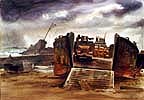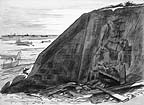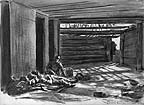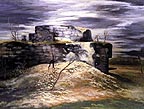 Wrecked
LCVP
Wrecked
LCVPAlexander P. Russo #34
Gouache, 1944
88-198-AH
The flotsam and jetsam of battle lay strewed about the battlefield. During the Normandy landings, German beach obstacles and defenses destroyed numerous Allied landing craft and vehicles in the approaches or on the beaches themselves. These twisted hulks were prominent reminders of the price paid for the successful invasion.
 Wrecked
LCVP
Wrecked
LCVP
Alexander P. Russo #34
Gouache, 1944
88-198-AH
It once held life. It was the staunch craft in which men were trained in landings on many practice beaches. It finally met its fate with its crew on a Normandy beach on D-Day.
 Burnt
Out LCT on American Beach
Burnt
Out LCT on American Beach
Mitchell Jamieson #228a
Watercolor, June 1944
88-193-IE
This is typical of some of the gutted wrecks along this most tragic of beaches. It had mobile anti-aircraft vehicles aboard and had been so completely ravaged by flame after being hit that its agonies had left it with a look somehow permanent and fixed in rigidity, as though suffering rigor mortis, in a way like a human corpse. A smashed LCIL is in the surf beyond the pontoon barge and an LCVP, or the remains of it, is in left foreground.
 Burnt
Out LCT on American Beach
Burnt
Out LCT on American Beach
Mitchell Jamieson #228
Charcoal & wash, June 1944
88-193-ID
Study for #228a.
 Wrecked
Amphibious Tank
Wrecked
Amphibious Tank
Mitchell Jamieson #V-30
Charcoal & wash, June, 1944
88-193-RF
This was an American "Sherman" tank, fitted out for amphibious operations.
 Wreckage
on British Beach – British Sector
Wreckage
on British Beach – British Sector
Mitchell Jamieson #V-40
Charcoal & wash, 16 June, 1944
88-193-RR
Wrecked landing craft, hit by the fire of German guns as they came ashore, litter the British invasion beaches. Such wreckage was scattered the length and breadth of the American, British and Canadian beaches at Normandy, and is the signature of a beach over which an amphibious landing encountered fierce resistance.
 Jerry
Pillbox on British Beach
Jerry
Pillbox on British Beach
Mitchell Jamieson #V-42
Charcoal & wash, 1944
88-193-RT
Pillboxes were smaller machine-gun positions protected by hardened fortifications of steel-reinforced concrete. These pillboxes and larger artillery bunkers were positioned to command wide swaths of beach in zones of interlocking fire.
 Interior
of German Pillbox Occupied by British Troops from Liverpool
Interior
of German Pillbox Occupied by British Troops from Liverpool
Mitchell Jamieson #V-41
Charcoal & wash, 15 June, 1944
88-193-RS
Once conquered, German concrete bunkers and pillboxes were used to protect Allied troops from German artillery fire and air raids.
 The
Dragon - Wrecked M4 Tank
The
Dragon - Wrecked M4 Tank
Mitchell Jamieson #218
Watercolor, June 1944
88-193-HS
This burnt-out General Sherman tank was evidently hit by a German "88" [a high-velocity 88mm anti-aircraft artillery gun which was also used as an effective anti-tank weapon] and set afire. It was then partly covered with sand, probably by our bulldozers clearing an exit from the beach. A little further back from the water, a tank ditch extended for a considerable length. Part of the tank’s amphibious air-intake duct, which allowed the tank to be driven through shallow water from ship to shore, was broken off . To the right, a group of African-American troops, amphibious "duck" [DUKW – a type of wheeled land and water vehicle] drivers, gathered around a fire.
German
Pillbox in a Normandy Field
Alexander P. Russo #35
Gouache, 1945
88-198-AI
This is one of the many pillboxes scattered through the hills facing the beaches. The field in the foreground is spiked with posts to prevent glider landings. Such pillboxes were put to good use by Allied troops as hardened shelters for first aid dressing stations and communications set-ups.
 Captured
German Gun Emplacement in a Normandy Field
Captured
German Gun Emplacement in a Normandy Field
Alexander P. Russo #45
Gouache, 1945
88-198-AS
Farm fields held many of these man-made terrain features - structures of cement, stone and steel that belched death and destruction against advancing troops. Some fitted snugly into contours of a hill slope in order better to escape air detection. Others stood boldly in fields, seemingly defiant, with only a casual horizontal cover of foliage. Some were taken while in process of construction. All had one purpose and one common design, which was to hurl out a message of death.
1 2 3 4 5 6 7 8 9 10 11 12 13 14 15 16 17 18 19 20 21 22 23 24 25